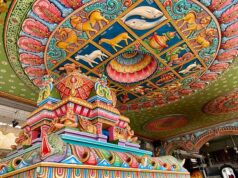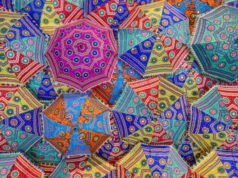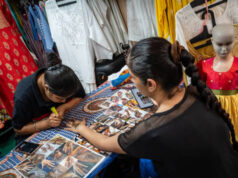Tradition Reinterpreted to the Present
Most of the time, it is like your heritage is a heavy chest stored in the attic–dusty, treasured, but most of the time forgotten until someone pries the chest open. That is what younger artists are undertaking with Peranakan craft, and the effects of such strike across singapore arts and culture. What was limited to porcelain dishes and embroidered kebayas is now reappearing in footwear, internet graphics and on the walls of the street. It is not the past that has been forgotten or locked away; rather, it is in the process of tacking and stitching and stripping away to daily life, being remixed.

Porcelain Plates to Pop Culture
Become a visitor at a weekend bazaar and you will see the change. It’s complicated; phoenixes originally sat on antique plates, but today they are flying across skateboards. Lingering summer flowers in beadwork, long limited to the slippers worn to weddings, are now winking on canvas tote bags. One artisan went so far as to digitize the old motifs and make them into Instagram filters. Heritage does not lie dormant–the edges wobble.
Respect Makes Rebellious
There is ever tension in revival. Elders feel threatened with dilution, whereas younger artists feel unless we adapt, tradition dies out. It is almost a pull-and-push like music. On one side are old refrains humming; on the other side beats are added. Collectively they create something that is grounded but unsteady. Lacking that friction, the craft is in danger of falling into the museum silence.
Why Handmade Still Matters
The efficiency is in mass production, but there is magic in the slow speed of working with hands. Imagine somebody sewing beads as small as they could pop off the end of a pin. Or a hack through wood blocks, wood carving designs that will imprint fabric. It’s painstaking. It’s stubborn. And this shows that paces are as much a part of a fast-paced city as speed.
Sustainability as an Unspoken Ally
The renaissance here is not about tradition only; it is also about principles. Oftentimes young designers trade synthetic dyes to use nature-derived alternatives or reuse fallen textiles to make something beautiful. A bag can have a Peranakan pattern, and the secret of cloth can be taken out of the landfill. Tradition prevails, and the world is saved.
The Tales Hidden in Symbols
A vase is not only clay. A slipper is not a piece of skin. Every pattern has a story–the path of migration, interracial marriage or the pride of a family. Young authors understand this. They work in meanings into everything, and intermingling with them all are bits of cards that explain the symbols. A bracelet is more than an accessory, and it is something you wear to remember.
Digital Platforms: Digital Platforms as the New Gallery
Traditionally, you would stare in a glass show family or during festivities. The Peranakan art is an art form that has taken Instagram by storm, wherein you will find tutorials on Peranakan beadwork, time-lapses of embroidery, or artists explaining motifs in short forms on Instagram. A hand-stitched clutch that takes a week to make in a little flat can be shipped to Europe. The lines are no longer what holds tradition.
Apprenticeship Rewritten
The old apprenticeship required generations of servitude to ruthless masters. The contemporary one has a totally different appearance. Classes in community centers, web-based tutorials and brief residencies have displaced a lifetime of servitude. Skills diffuse quicker and to more individuals. The downside? Others fear that shortcuts are poached on depth. The upside? A craft that was previously practiced behind closed doors is now virtually open to anyone who is intrigued to practice it.
Striking a Balance between Trade and Craft
Unless you can pay the rent, passion is not the way. This is the reason why craftsmanship has drawn a lot of young entrepreneurs. They produce small collections, pop-up stores, and partnerships with lifestyle brands. Other people do crowdfunding on their projects. These strategies not only do not demean the work, but they are also the keys enabling craft to survive. Without heritage being able to sustain itself, there is a risk of it disappearing no matter how valuable.
Social and Community Support and Institutional Support
It is good to know that cultural groups and community projects offer platforms. The heritage festivals feature young artisans. Grants enable them to do something radically different; they have the guarantee of failure. In the absence of this, many students would not afford to practice in a city where even space to practice in a studio seems like a luxury.
Youth Care Deeply
Critics will say that the younger Singaporeans are too westernized and too estranged in matters regarding their roots. Still the revival explains another story. It is not merely a fashion statement to wear sneakers patterned in Peranakan designs–it is a statement of identity. It adds, “This is my culture, kicking and screaming.” It is also influential in a city where cultures are regularly in conflict with high-rises and flashing lights.
Everyday Heritage
The most impressive aspect of this rebirth is that even the common materials are charged with the extra history. Peranakan-inspired murals decorate the plaster walls of cafes. Phone cases bring colored tiles that were limited to kitchen floors. Regular earrings that take the form of old designs are worn hanging casually in office cubicles. The heritage has fallen out of the glass cabinet and found itself in the lunch line.
The Conflict of Past and Future
Nevertheless, there is vulnerability. When artists take the design too far, the designs lose context. When they are too hung on, relevance dies away. It is a delicate balancing act, like walking a tightrope in between two generations. But maybe this is what is magic about–the one foot rooted in the past and the other foot stepping into the future.
Seeing Past the Superficial
The impressive thing about this revival isn’t just its looks. It is how emerging artists take a traditional practice and use it as a ladder as they go along constructing new ones. They remind us that culture is not a museum piece–it is still a lump of clay we can still shape. Peranakan Craft–because it did not break, it twisted around.
It is in that tapestry that the true story can be found: having a past alive and so current, having a present bursting with creativeness, and having a future where tradition will be right by the side of modernity but not trailing behind.










